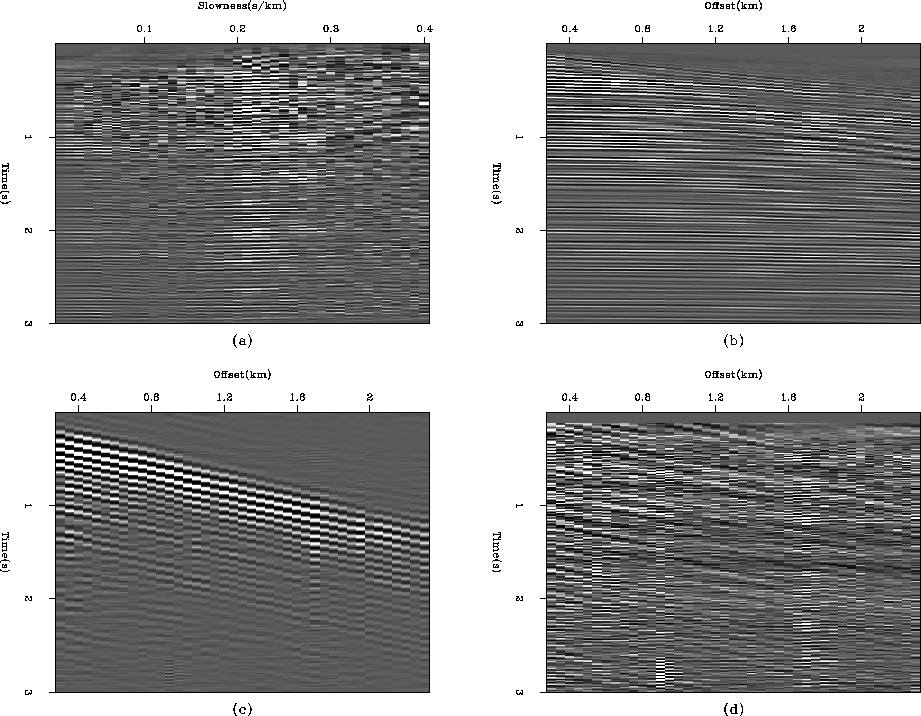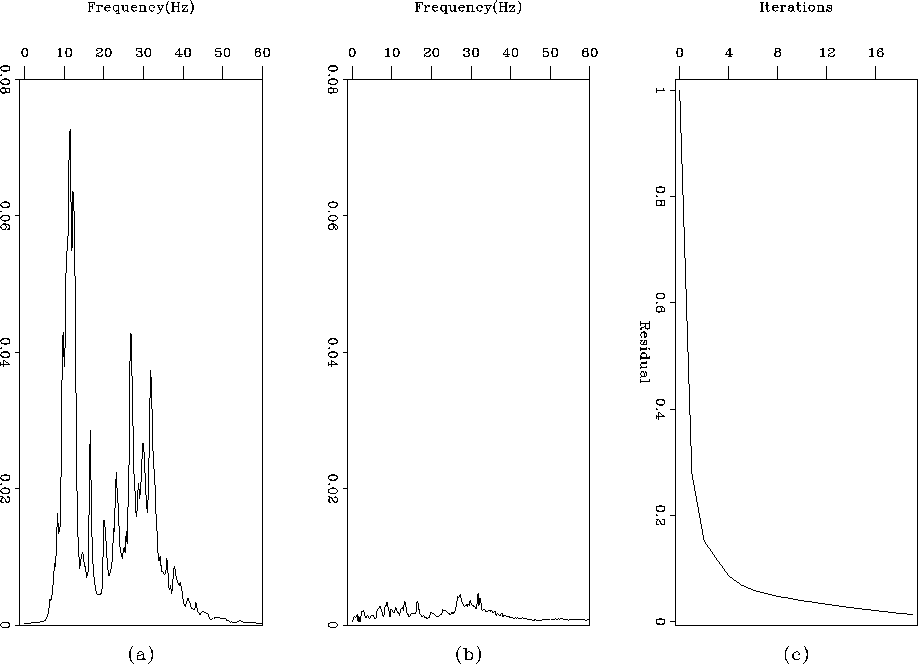




Next: Discussion of the subtraction
Up: Subtracting coherent noise
Previous: Subtracting the coherent noise
For purposes of comparison, I used the CMP gather of Figure
6 again. The filter size
is as before (a=30,1). I iterated 45 times before estimating
the PEF for the coherent noise. Then I iterated 20 times, for a total
of 65 iterations.
The coherent noise attenuation again resembles that obtained with the filtering approach.
In Figure 15, I show the result of the inversion. Figure
15a displays the model space, Figure
15b the reconstructed data from 15a, Figure
15c the noise model for the data ( ),
and Figure 15d the residual. The noise model is mainly
composed of the coherent noise I am trying to attenuate. The residual
shows linear events scattered throughout the panel. I think
this problem can be partially solved using nonstationary filters
as opposed to a stationary one Guitton et al. (2001).
The importance of the linear events in the residual does not, however,
negate the efficiency of this method. Because the amplitude spectrum
of the residual in Figure 16b is whiter than the
spectrum of the input data in Figure 16a, the fitting
of the data was successful.
),
and Figure 15d the residual. The noise model is mainly
composed of the coherent noise I am trying to attenuate. The residual
shows linear events scattered throughout the panel. I think
this problem can be partially solved using nonstationary filters
as opposed to a stationary one Guitton et al. (2001).
The importance of the linear events in the residual does not, however,
negate the efficiency of this method. Because the amplitude spectrum
of the residual in Figure 16b is whiter than the
spectrum of the input data in Figure 16a, the fitting
of the data was successful.
compwz
Figure 15 Subtracting the coherent
noise in real data. (a) An estimated model space. (b)
The reconstructed data from the model space. (c) The estimated
coherent noise  . (d) The residual after inversion.
Click Movie to see how the four panels evolve as the iterations continue.
. (d) The residual after inversion.
Click Movie to see how the four panels evolve as the iterations continue.
![[*]](http://sepwww.stanford.edu/latex2html/movie.gif)




 compwf
compwf
Figure 16 (a) The amplitude spectrum of
the input data in Figure 6a. (b) The amplitude spectrum
of the residual after inversion. (c) The normalized objective
function. Click Movie to see how the two panels b and c evolve
as the iterations continue.
![[*]](http://sepwww.stanford.edu/latex2html/movie.gif)










Next: Discussion of the subtraction
Up: Subtracting coherent noise
Previous: Subtracting the coherent noise
Stanford Exploration Project
4/29/2001
![]() ),
and Figure 15d the residual. The noise model is mainly
composed of the coherent noise I am trying to attenuate. The residual
shows linear events scattered throughout the panel. I think
this problem can be partially solved using nonstationary filters
as opposed to a stationary one Guitton et al. (2001).
The importance of the linear events in the residual does not, however,
negate the efficiency of this method. Because the amplitude spectrum
of the residual in Figure 16b is whiter than the
spectrum of the input data in Figure 16a, the fitting
of the data was successful.
),
and Figure 15d the residual. The noise model is mainly
composed of the coherent noise I am trying to attenuate. The residual
shows linear events scattered throughout the panel. I think
this problem can be partially solved using nonstationary filters
as opposed to a stationary one Guitton et al. (2001).
The importance of the linear events in the residual does not, however,
negate the efficiency of this method. Because the amplitude spectrum
of the residual in Figure 16b is whiter than the
spectrum of the input data in Figure 16a, the fitting
of the data was successful.

![[*]](http://sepwww.stanford.edu/latex2html/movie.gif)

![[*]](http://sepwww.stanford.edu/latex2html/movie.gif)